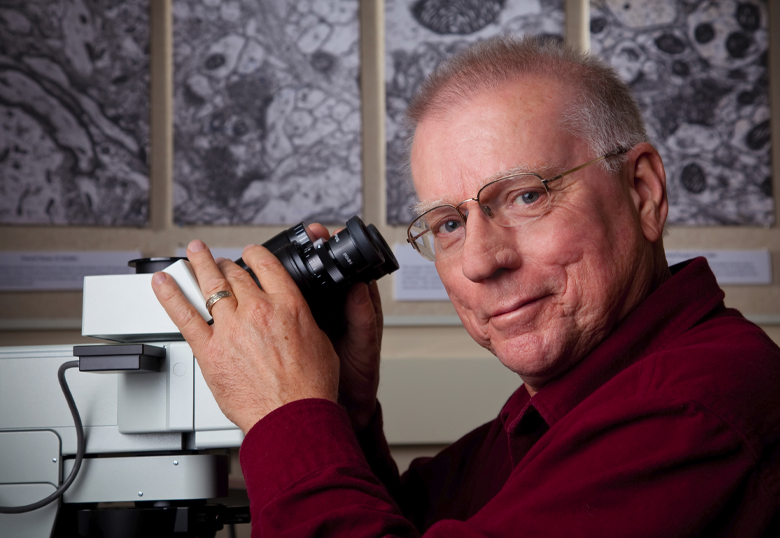University of Lethbridge researchers are looking at the potential for cannabis compounds to treat or even prevent Alzheimer’s disease, as well as to track and possibly stop abnormal proteins from spreading damage in the brain with $1.8 million in funding grants from the Canadian Institutes of Health Research (CIHR).

“There’s preliminary work in the field that’s emerged just recently, particularly in animal models, suggesting that cannabis compounds can reverse brain pathology and cognitive impairments,” says McDonald. “We’re really interested in trying to prevent that descent into neurodegeneration and dementia because once the brain has changed, it’s very hard to bring it back. If we can prevent or prolong that descent into dementia, that’s really the goal.”
In the other project, Dr. Robert Sutherland and his team at the CCBN will use an animal model to look more closely at two misfolded proteins associated with Alzheimer’s disease — amyloid beta and tau. They will be digging into how these two proteins may spread in the brain and how the spread coincides with memory loss and decreased cognitive function, as well as trying to block the spread.

“We want to understand the basic biological mechanisms that push the disease forward in the brain,” says Sutherland. “Ultimately, we hope this kind of research will lead us to a cure, the same way vaccinations got rid of smallpox or polio, and that we’ll be able to come up with a way of absolutely preventing and stopping it. That’s my long-term goal.”
Cannabis and Alzheimer’s disease
As baby boomers age, Canada could be facing a health care crisis. Alzheimer’s disease currently affects about 500,000 people in Canada but that number is expected to increase to almost 940,000 by 2031. The costs, in terms of reduced quality of life, the burden on caregivers and financial expenses, will balloon.
“The treatments that have been developed so far are few, they’re not particularly effective and they ultimately do not prevent the descent into dementia,” says McDonald. “The treatment approach we’re investigating is exciting because cannabis compounds appear to target several pathologies that are found in Alzheimer’s disease and these compounds are available, inexpensive and relatively safe for human consumption. We’re just at the tip of the iceberg of understanding the cannabinoids, how complex they are, and what effects they may have on the brain and the body.”
McDonald adds that, while cannabis compounds are showing promise, it doesn’t mean every older adult should start using cannabis. Much work needs to be done to determine the correct combination of compounds, the doses required, the length of treatment and who the treatment might be appropriate for. As part of their research, they will also examine sex differences because the brain changes that come with Alzheimer’s disease differ between females and males.
“We have an incredible research team, including Drs. Rob Sutherland and Majid Mohajerani and my long-term collaborator Nhung Hong, that’s extensively involved in this work,” says McDonald. “Dr. Igor Kovalchuk is our cannabinoid expert so we’re working on combinations and cocktails with him. I have an incredible grad student, Abigail Nixon, who’s been working night and day this year trying to get preliminary data to support this work. And there’s this amazing crew of undergrads over the year who have been doing independent studies to help collect this preliminary data as well.”
Misfolded proteins and Alzheimer’s disease
Sutherland, along with the CCBN’s Dr. Majid Mohajerani and Dr. David Westaway at the Centre for Prions and Protein Folding Diseases at the University of Alberta, will be injecting mice with abnormal proteins and observing how they spread through the brain.
“We’re mainly looking at the cortex, since that’s where lots of memory and cognitive activity takes place,” says Sutherland. “We can measure how the brain activity changes as these abnormal proteins creep into circuits in the cortex. We’ll periodically assess the animal’s memory ability to see the moment when memory breaks down in these animals and what’s exactly happening in the cortex when that breakdown occurs.”
Once the researchers have developed a careful description of how the spread occurs through the brain and how cognition is affected, they plan to test different ways to block the spread. They may be able to block the spread by modifying microglial cells. These cells are a front-line defense when things go wrong and they work to break down abnormal proteins like amyloid beta and tau. But when the abnormal proteins increase, these cells become overwhelmed and, instead of destroying the bad proteins, spit them back out in a different location. The researchers want to determine if the cells may be contributing to the spread of the bad proteins, and, if that’s the case, then reducing their activity might help prevent spreading. They also plan to test whether increasing or decreasing activity in select nerve fibres will affect the spreading of the abnormal proteins.
“We can absolutely decide whether increasing or decreasing activity in the part of the brain that produces new memories causes more spread or reduces the spread,” says Sutherland. “Most people would predict that increasing brain activity would decrease spread and we’re going to find out whether that’s really true.”
Sutherland credits Campus Alberta Neuroscience for helping to build a strong network of researchers in the province dedicated to aging and neurodegenerative diseases. In addition, the Alzheimer’s Society of Alberta and Northwest Territories has invested in research being done by the network.
“That is now really paying off, in terms of the number of CIHR grants directed toward brain aging and dementia,” says Sutherland. “I don’t think we would have been able to get those grants without that catalyst funding from the Alzheimer’s Society. We owe them a big debt. The Alzheimer Society’s funding comes from lots of small donations. It’s not a big wealthy group; it’s just ordinary people giving a few dollars.”
